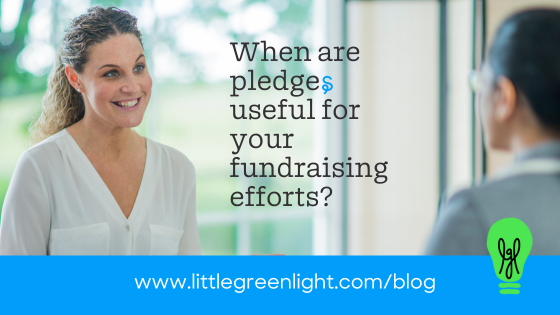Little Green Light is a cloud-based donor management system for fundraisers.
Subscribe to get our latest product updates, best practices and tips to grow your nonprofit.

While a useful tool in some scenarios, pledges can also be the source of a lot of unnecessary work for a fundraiser. To get some perspective on whether or not to use pledges, I chatted with Sarah Lange, author of The Field Guide to Fundraising for Nonprofits.
A pledge is a promise to donate a specific sum to an organization. The donor fulfills the pledge at a later date, either by making one payment or multiple payments. For example: If I make a pledge to your organization, I make a commitment to pay a total amount, such as $5,000. I may opt to pay in four installments of $1,250 or 10 installments of $500. The point is that I’m promising to pay a specified amount over a set period of time.
Sarah notes that pledges “require carefully-constructed campaigns that include specific timeframes and conditions. They can work well for urgent needs, capital campaigns, and advocacy work. The idea with a pledge campaign is to quickly collect promises of support, so it should be done over a relatively short period of time so you can maintain the energy and momentum.” Some examples that Sarah shares include: Disaster relief and other crises, advocacy or community work around a time-sensitive issue, purchasing the building you’ve been renting or some other large capital expenditure, covering a large and unexpected expense, and raising money for a new program or project.
Pledges can also be useful when soliciting major donors because they give donors a mechanism “to uplevel their investment, yet do so over time.”
Pledges require a considerable investment of time from your organization, as they require ongoing, careful management. You’ll need to be able to track the total amount pledged, the payment schedule, the amount paid so far, and the outstanding balance. You’ll also need to send reminders to donors as their installments come due (and sometimes when they’re past due). In Sarah’s experience, past due payments are often the result of forgetfulness, so a polite reminder or two can go a long way toward collecting those payments. Sarah also recognizes that about 85% of pledges get paid. This means that for the remaining 15% or so, you’ll need a way to write-off those pledges.
Conclusion
Pledges can help your organization raise funds, but only in specific situations. By being judicious in your use of pledges and recognizing when they are and aren’t a useful tool, you can concentrate your time and energy effectively.
If you determine that pledges are the right tool for your fundraising effort, check out these resources for working with them:
Entering a pledge in your donor management system
What to do with unfulfilled pledges
6 tips for successfully acknowledging pledges
About Sarah Lange:
Sarah helps nonprofits adopt better practices so they make a bigger impact in the world. She consults, writes blogs, articles, teaches, runs workshops, and makes presentations at conferences in an effort to share her strategies and ideas with a larger audience. She’s also held teaching posts at Boston University School of Social Work, Worcester State College, Assumption College, Clark University, and UMass Boston.
Ready to try LGL? Get your first 30 days free. No credit card required.